ICT Sustainability Report: Planning and Design for IDMC Compliance
VerifiedAdded on 2023/05/30
|40
|4830
|479
Report
AI Summary
This report outlines sustainable methods for International Digital Marketing Company (IDMC) to comply with Australian environmental regulations, focusing on energy consumption and waste reduction. It details suitable sustainable projects such as e-waste management, paperless office initiatives, SSD implementation, and cloud computing adoption. The report explores the impacts of cloud computing, transferable and non-transferable operations, and various technology and green solutions like Dropbox, TeamViewer, SSDs, and LED monitors. A cost-benefit analysis is provided, along with a power supply audit and energy consumption estimates. Short-term solutions, sustainable management principles, and key performance indicators (KPIs) for Optus and ADMC are discussed. The report also covers virtualization opportunities, energy cost estimation for college and IDMC settings, an energy-saving report, ROI, and CO2 emission estimates, culminating in recommendations and a conclusion. The document includes tables and figures illustrating power usage and utility for various devices.
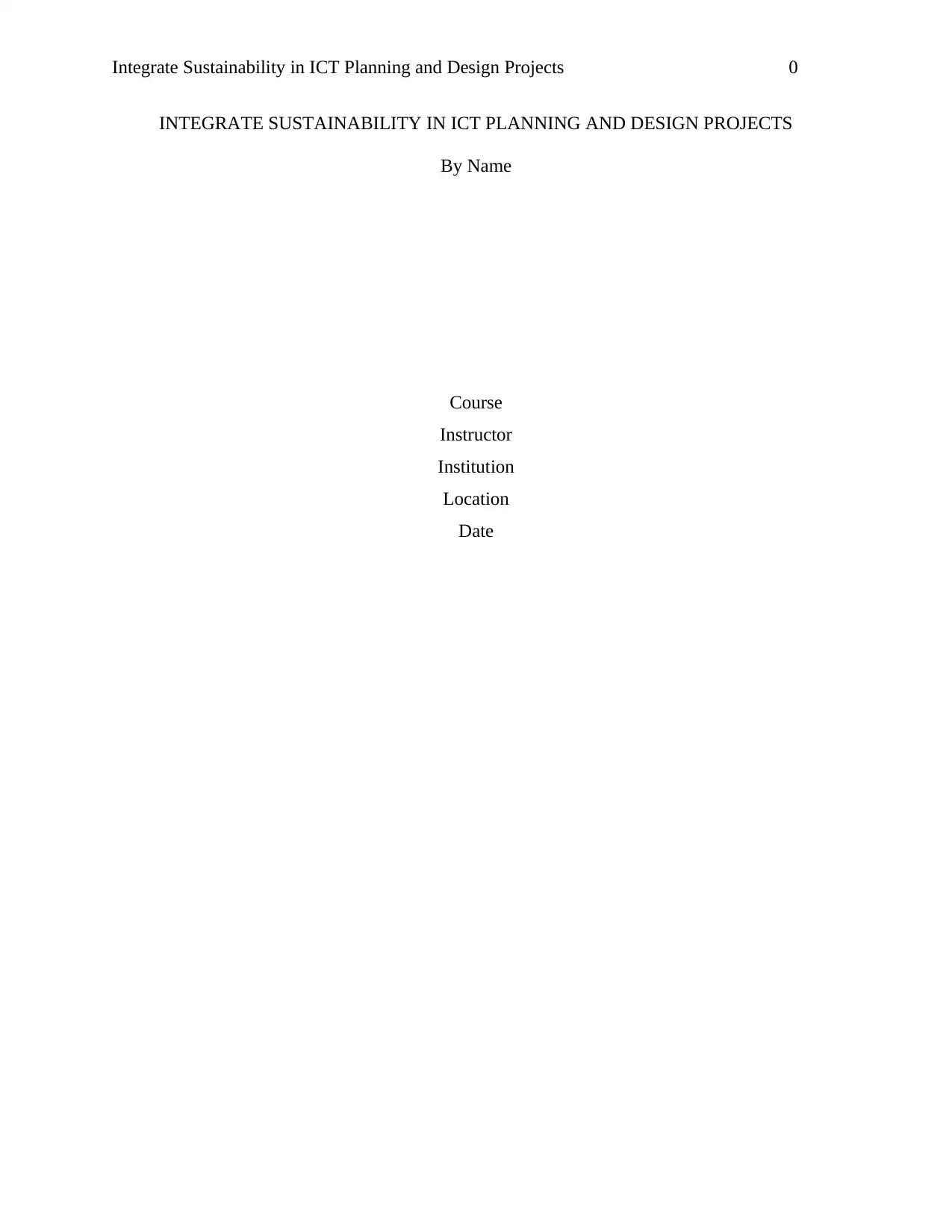
Integrate Sustainability in ICT Planning and Design Projects 0
INTEGRATE SUSTAINABILITY IN ICT PLANNING AND DESIGN PROJECTS
By Name
Course
Instructor
Institution
Location
Date
INTEGRATE SUSTAINABILITY IN ICT PLANNING AND DESIGN PROJECTS
By Name
Course
Instructor
Institution
Location
Date
Paraphrase This Document
Need a fresh take? Get an instant paraphrase of this document with our AI Paraphraser
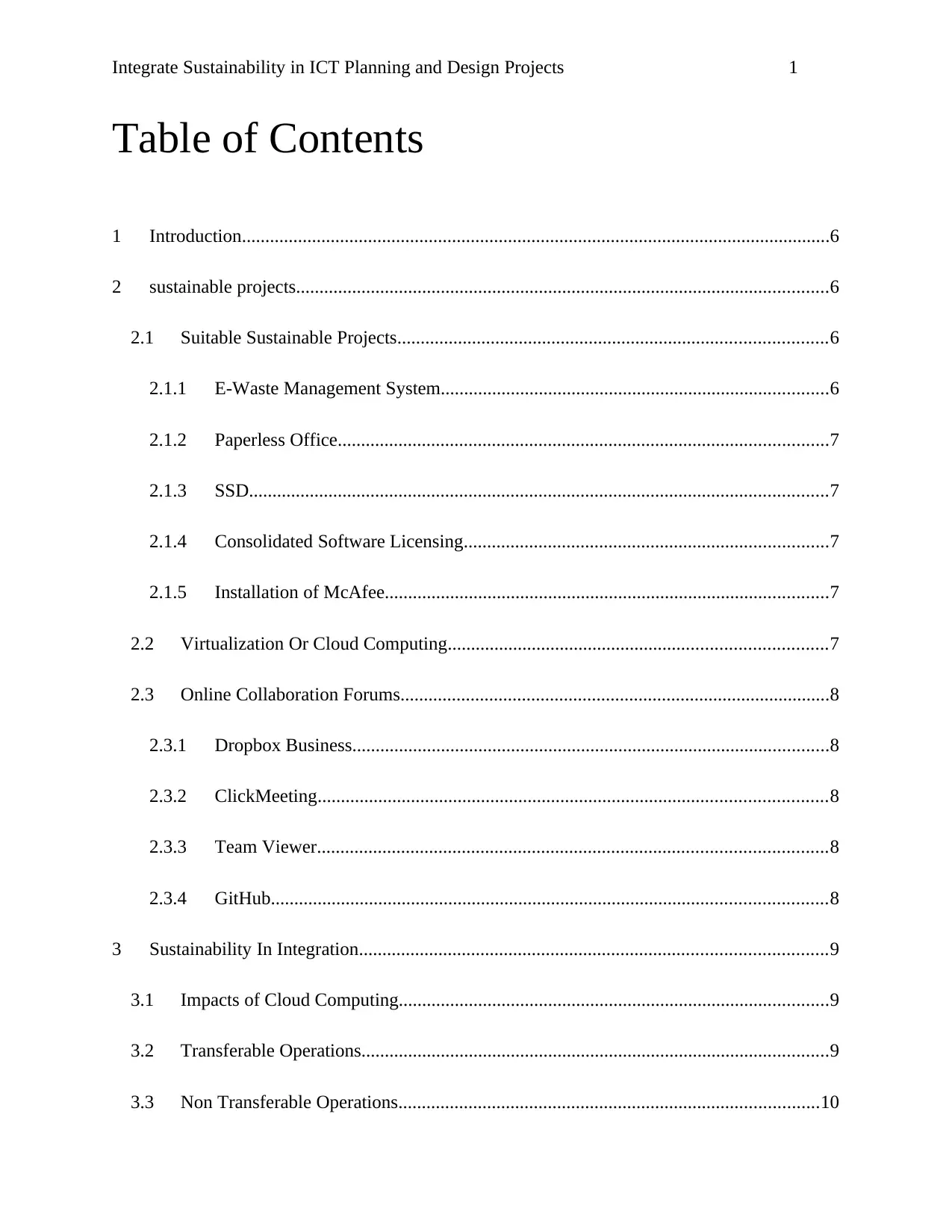
Integrate Sustainability in ICT Planning and Design Projects 1
Table of Contents
1 Introduction..............................................................................................................................6
2 sustainable projects..................................................................................................................6
2.1 Suitable Sustainable Projects............................................................................................6
2.1.1 E-Waste Management System...................................................................................6
2.1.2 Paperless Office.........................................................................................................7
2.1.3 SSD............................................................................................................................7
2.1.4 Consolidated Software Licensing..............................................................................7
2.1.5 Installation of McAfee...............................................................................................7
2.2 Virtualization Or Cloud Computing.................................................................................7
2.3 Online Collaboration Forums............................................................................................8
2.3.1 Dropbox Business......................................................................................................8
2.3.2 ClickMeeting.............................................................................................................8
2.3.3 Team Viewer.............................................................................................................8
2.3.4 GitHub.......................................................................................................................8
3 Sustainability In Integration....................................................................................................9
3.1 Impacts of Cloud Computing............................................................................................9
3.2 Transferable Operations....................................................................................................9
3.3 Non Transferable Operations..........................................................................................10
Table of Contents
1 Introduction..............................................................................................................................6
2 sustainable projects..................................................................................................................6
2.1 Suitable Sustainable Projects............................................................................................6
2.1.1 E-Waste Management System...................................................................................6
2.1.2 Paperless Office.........................................................................................................7
2.1.3 SSD............................................................................................................................7
2.1.4 Consolidated Software Licensing..............................................................................7
2.1.5 Installation of McAfee...............................................................................................7
2.2 Virtualization Or Cloud Computing.................................................................................7
2.3 Online Collaboration Forums............................................................................................8
2.3.1 Dropbox Business......................................................................................................8
2.3.2 ClickMeeting.............................................................................................................8
2.3.3 Team Viewer.............................................................................................................8
2.3.4 GitHub.......................................................................................................................8
3 Sustainability In Integration....................................................................................................9
3.1 Impacts of Cloud Computing............................................................................................9
3.2 Transferable Operations....................................................................................................9
3.3 Non Transferable Operations..........................................................................................10
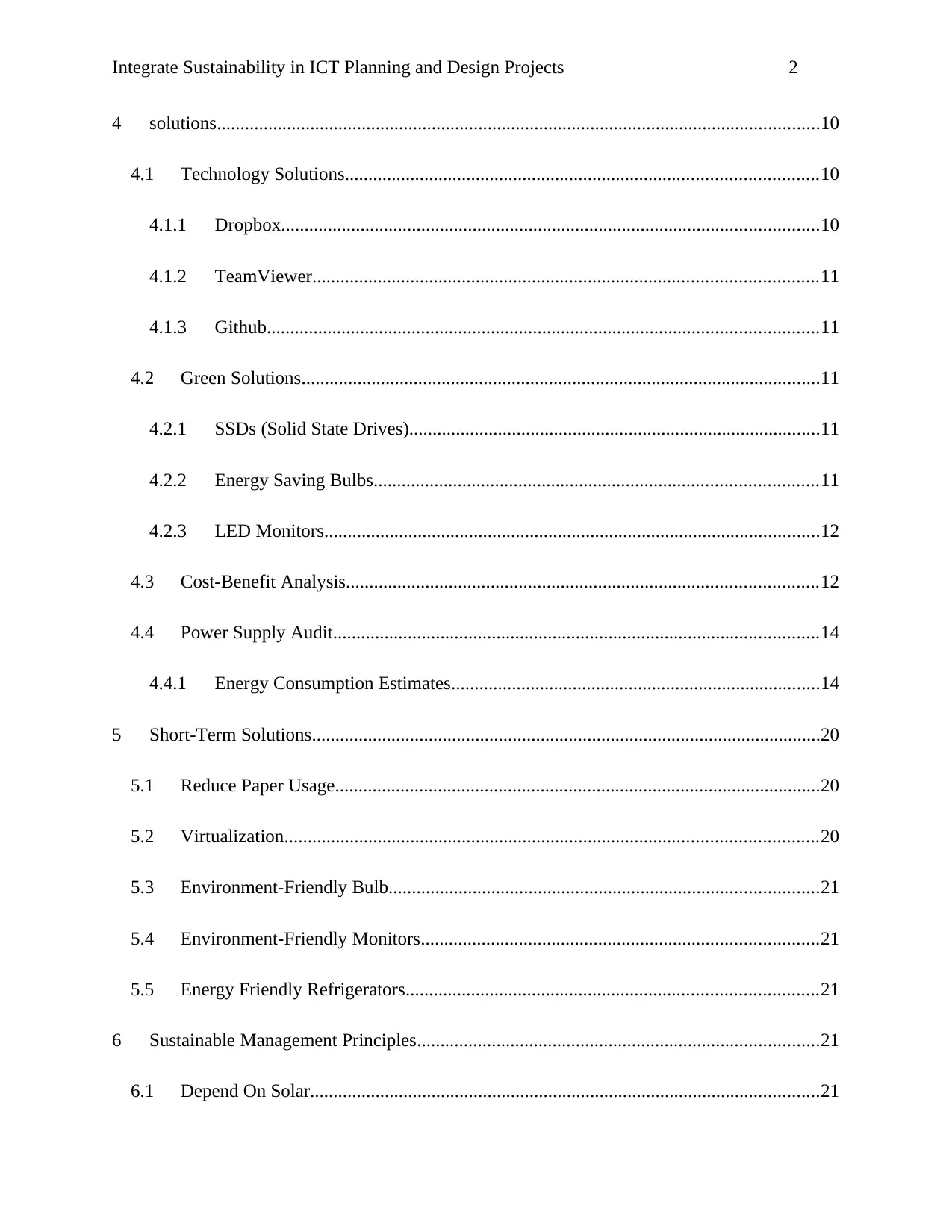
Integrate Sustainability in ICT Planning and Design Projects 2
4 solutions.................................................................................................................................10
4.1 Technology Solutions.....................................................................................................10
4.1.1 Dropbox...................................................................................................................10
4.1.2 TeamViewer............................................................................................................11
4.1.3 Github......................................................................................................................11
4.2 Green Solutions...............................................................................................................11
4.2.1 SSDs (Solid State Drives)........................................................................................11
4.2.2 Energy Saving Bulbs...............................................................................................11
4.2.3 LED Monitors..........................................................................................................12
4.3 Cost-Benefit Analysis.....................................................................................................12
4.4 Power Supply Audit........................................................................................................14
4.4.1 Energy Consumption Estimates...............................................................................14
5 Short-Term Solutions.............................................................................................................20
5.1 Reduce Paper Usage........................................................................................................20
5.2 Virtualization..................................................................................................................20
5.3 Environment-Friendly Bulb............................................................................................21
5.4 Environment-Friendly Monitors.....................................................................................21
5.5 Energy Friendly Refrigerators........................................................................................21
6 Sustainable Management Principles......................................................................................21
6.1 Depend On Solar.............................................................................................................21
4 solutions.................................................................................................................................10
4.1 Technology Solutions.....................................................................................................10
4.1.1 Dropbox...................................................................................................................10
4.1.2 TeamViewer............................................................................................................11
4.1.3 Github......................................................................................................................11
4.2 Green Solutions...............................................................................................................11
4.2.1 SSDs (Solid State Drives)........................................................................................11
4.2.2 Energy Saving Bulbs...............................................................................................11
4.2.3 LED Monitors..........................................................................................................12
4.3 Cost-Benefit Analysis.....................................................................................................12
4.4 Power Supply Audit........................................................................................................14
4.4.1 Energy Consumption Estimates...............................................................................14
5 Short-Term Solutions.............................................................................................................20
5.1 Reduce Paper Usage........................................................................................................20
5.2 Virtualization..................................................................................................................20
5.3 Environment-Friendly Bulb............................................................................................21
5.4 Environment-Friendly Monitors.....................................................................................21
5.5 Energy Friendly Refrigerators........................................................................................21
6 Sustainable Management Principles......................................................................................21
6.1 Depend On Solar.............................................................................................................21
⊘ This is a preview!⊘
Do you want full access?
Subscribe today to unlock all pages.

Trusted by 1+ million students worldwide
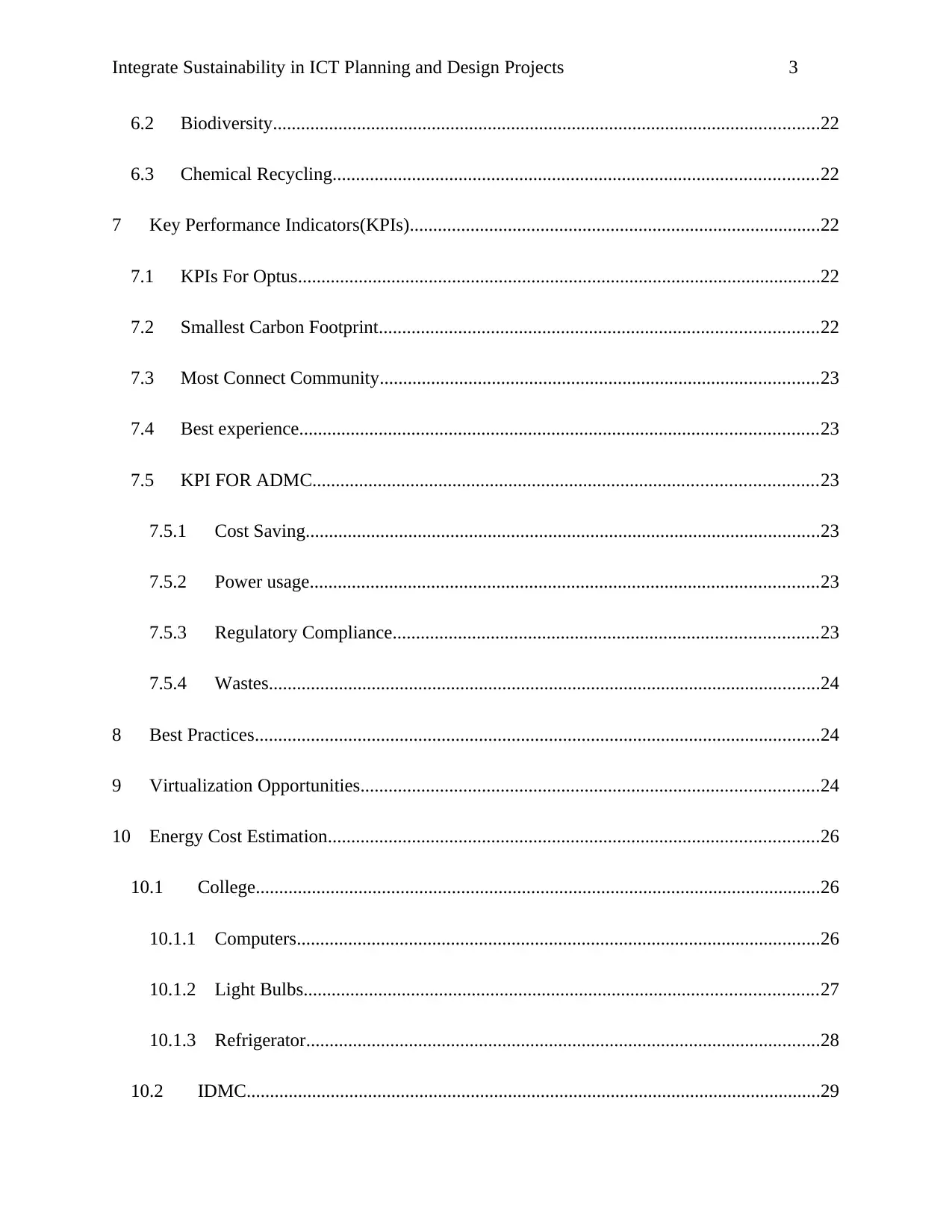
Integrate Sustainability in ICT Planning and Design Projects 3
6.2 Biodiversity.....................................................................................................................22
6.3 Chemical Recycling........................................................................................................22
7 Key Performance Indicators(KPIs)........................................................................................22
7.1 KPIs For Optus................................................................................................................22
7.2 Smallest Carbon Footprint..............................................................................................22
7.3 Most Connect Community..............................................................................................23
7.4 Best experience...............................................................................................................23
7.5 KPI FOR ADMC............................................................................................................23
7.5.1 Cost Saving..............................................................................................................23
7.5.2 Power usage.............................................................................................................23
7.5.3 Regulatory Compliance...........................................................................................23
7.5.4 Wastes......................................................................................................................24
8 Best Practices.........................................................................................................................24
9 Virtualization Opportunities..................................................................................................24
10 Energy Cost Estimation.........................................................................................................26
10.1 College.........................................................................................................................26
10.1.1 Computers................................................................................................................26
10.1.2 Light Bulbs..............................................................................................................27
10.1.3 Refrigerator..............................................................................................................28
10.2 IDMC...........................................................................................................................29
6.2 Biodiversity.....................................................................................................................22
6.3 Chemical Recycling........................................................................................................22
7 Key Performance Indicators(KPIs)........................................................................................22
7.1 KPIs For Optus................................................................................................................22
7.2 Smallest Carbon Footprint..............................................................................................22
7.3 Most Connect Community..............................................................................................23
7.4 Best experience...............................................................................................................23
7.5 KPI FOR ADMC............................................................................................................23
7.5.1 Cost Saving..............................................................................................................23
7.5.2 Power usage.............................................................................................................23
7.5.3 Regulatory Compliance...........................................................................................23
7.5.4 Wastes......................................................................................................................24
8 Best Practices.........................................................................................................................24
9 Virtualization Opportunities..................................................................................................24
10 Energy Cost Estimation.........................................................................................................26
10.1 College.........................................................................................................................26
10.1.1 Computers................................................................................................................26
10.1.2 Light Bulbs..............................................................................................................27
10.1.3 Refrigerator..............................................................................................................28
10.2 IDMC...........................................................................................................................29
Paraphrase This Document
Need a fresh take? Get an instant paraphrase of this document with our AI Paraphraser
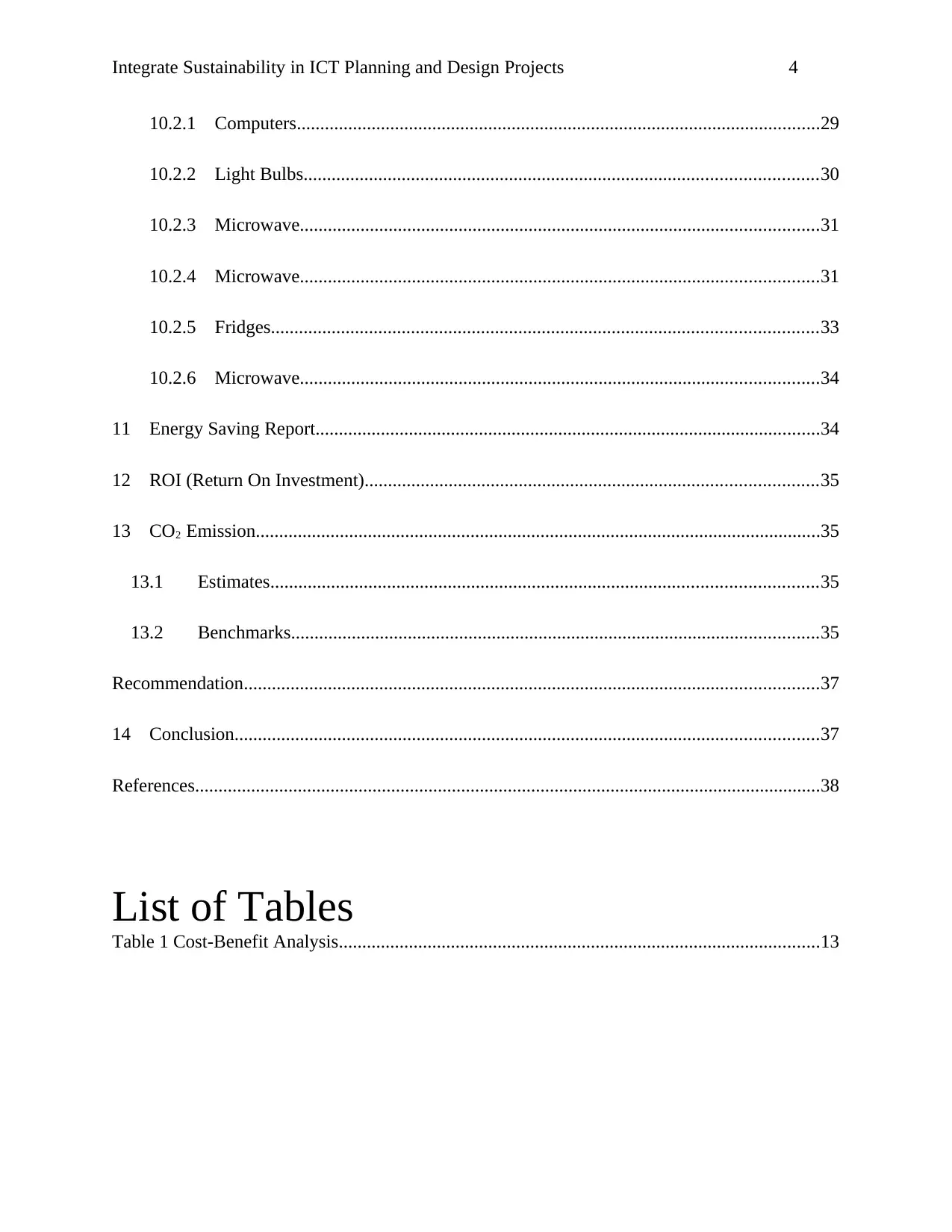
Integrate Sustainability in ICT Planning and Design Projects 4
10.2.1 Computers................................................................................................................29
10.2.2 Light Bulbs..............................................................................................................30
10.2.3 Microwave...............................................................................................................31
10.2.4 Microwave...............................................................................................................31
10.2.5 Fridges.....................................................................................................................33
10.2.6 Microwave...............................................................................................................34
11 Energy Saving Report............................................................................................................34
12 ROI (Return On Investment).................................................................................................35
13 CO2 Emission.........................................................................................................................35
13.1 Estimates.....................................................................................................................35
13.2 Benchmarks.................................................................................................................35
Recommendation...........................................................................................................................37
14 Conclusion.............................................................................................................................37
References......................................................................................................................................38
List of Tables
Table 1 Cost-Benefit Analysis.......................................................................................................13
10.2.1 Computers................................................................................................................29
10.2.2 Light Bulbs..............................................................................................................30
10.2.3 Microwave...............................................................................................................31
10.2.4 Microwave...............................................................................................................31
10.2.5 Fridges.....................................................................................................................33
10.2.6 Microwave...............................................................................................................34
11 Energy Saving Report............................................................................................................34
12 ROI (Return On Investment).................................................................................................35
13 CO2 Emission.........................................................................................................................35
13.1 Estimates.....................................................................................................................35
13.2 Benchmarks.................................................................................................................35
Recommendation...........................................................................................................................37
14 Conclusion.............................................................................................................................37
References......................................................................................................................................38
List of Tables
Table 1 Cost-Benefit Analysis.......................................................................................................13
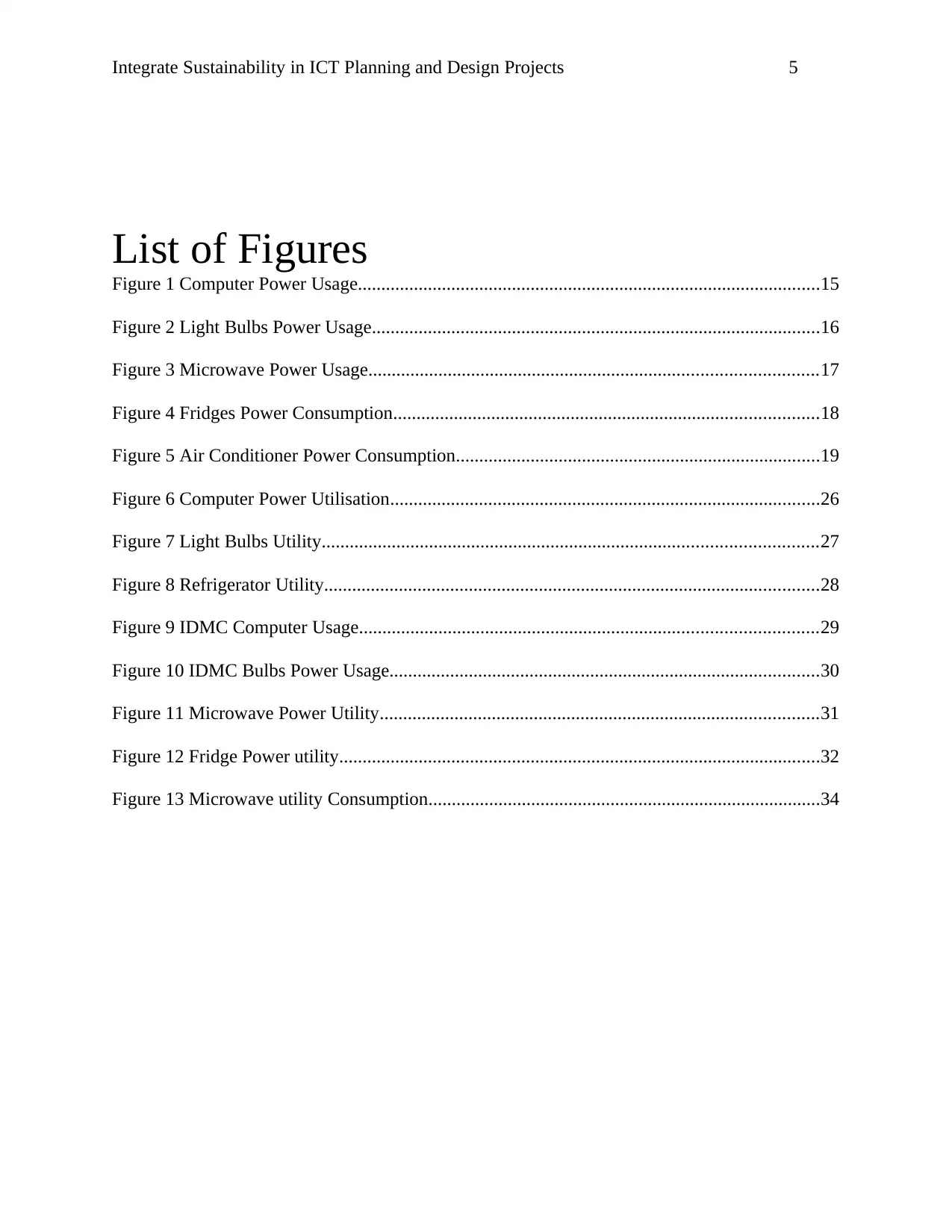
Integrate Sustainability in ICT Planning and Design Projects 5
List of Figures
Figure 1 Computer Power Usage...................................................................................................15
Figure 2 Light Bulbs Power Usage................................................................................................16
Figure 3 Microwave Power Usage................................................................................................17
Figure 4 Fridges Power Consumption...........................................................................................18
Figure 5 Air Conditioner Power Consumption..............................................................................19
Figure 6 Computer Power Utilisation............................................................................................26
Figure 7 Light Bulbs Utility..........................................................................................................27
Figure 8 Refrigerator Utility..........................................................................................................28
Figure 9 IDMC Computer Usage..................................................................................................29
Figure 10 IDMC Bulbs Power Usage............................................................................................30
Figure 11 Microwave Power Utility..............................................................................................31
Figure 12 Fridge Power utility.......................................................................................................32
Figure 13 Microwave utility Consumption....................................................................................34
List of Figures
Figure 1 Computer Power Usage...................................................................................................15
Figure 2 Light Bulbs Power Usage................................................................................................16
Figure 3 Microwave Power Usage................................................................................................17
Figure 4 Fridges Power Consumption...........................................................................................18
Figure 5 Air Conditioner Power Consumption..............................................................................19
Figure 6 Computer Power Utilisation............................................................................................26
Figure 7 Light Bulbs Utility..........................................................................................................27
Figure 8 Refrigerator Utility..........................................................................................................28
Figure 9 IDMC Computer Usage..................................................................................................29
Figure 10 IDMC Bulbs Power Usage............................................................................................30
Figure 11 Microwave Power Utility..............................................................................................31
Figure 12 Fridge Power utility.......................................................................................................32
Figure 13 Microwave utility Consumption....................................................................................34
⊘ This is a preview!⊘
Do you want full access?
Subscribe today to unlock all pages.

Trusted by 1+ million students worldwide
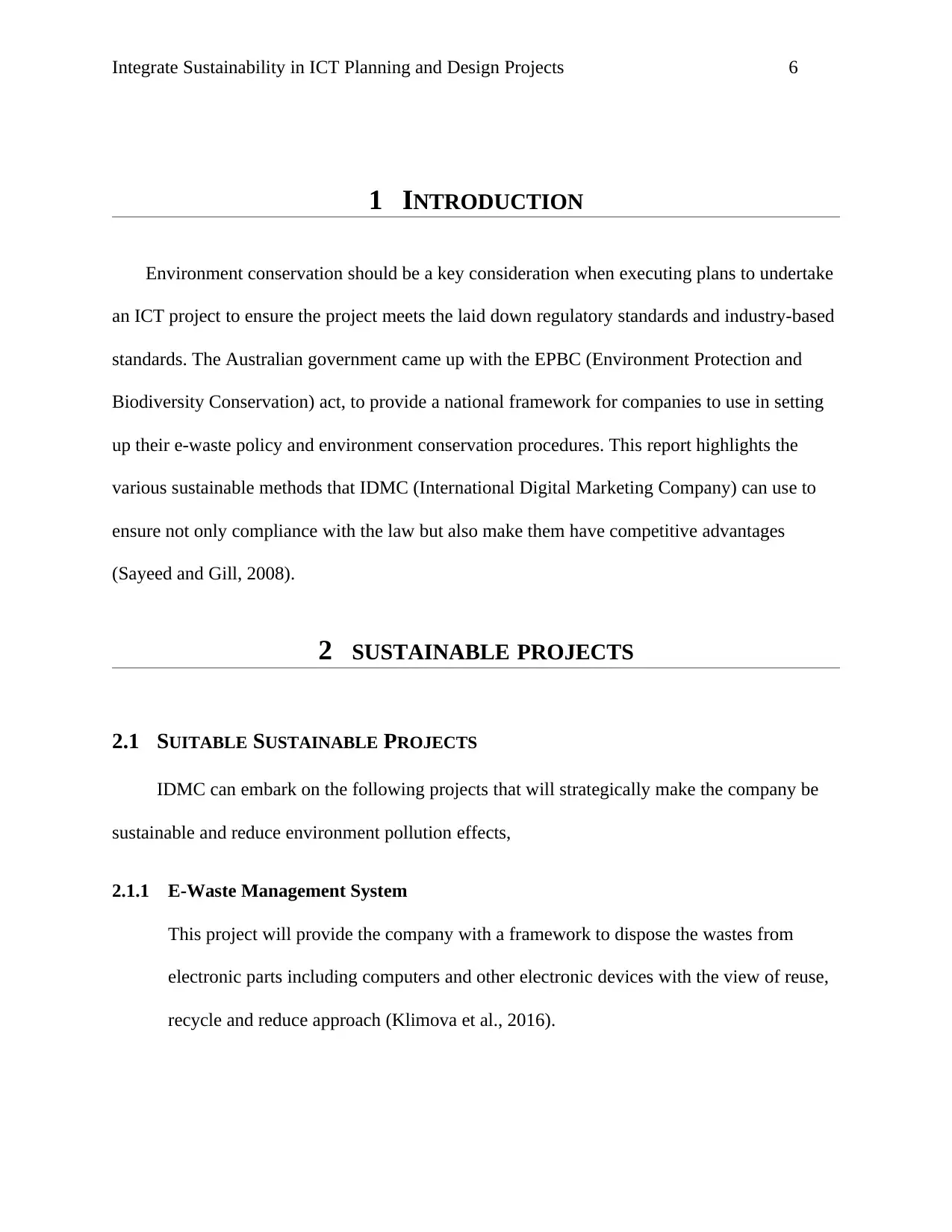
Integrate Sustainability in ICT Planning and Design Projects 6
1 INTRODUCTION
Environment conservation should be a key consideration when executing plans to undertake
an ICT project to ensure the project meets the laid down regulatory standards and industry-based
standards. The Australian government came up with the EPBC (Environment Protection and
Biodiversity Conservation) act, to provide a national framework for companies to use in setting
up their e-waste policy and environment conservation procedures. This report highlights the
various sustainable methods that IDMC (International Digital Marketing Company) can use to
ensure not only compliance with the law but also make them have competitive advantages
(Sayeed and Gill, 2008).
2 SUSTAINABLE PROJECTS
2.1 SUITABLE SUSTAINABLE PROJECTS
IDMC can embark on the following projects that will strategically make the company be
sustainable and reduce environment pollution effects,
2.1.1 E-Waste Management System
This project will provide the company with a framework to dispose the wastes from
electronic parts including computers and other electronic devices with the view of reuse,
recycle and reduce approach (Klimova et al., 2016).
1 INTRODUCTION
Environment conservation should be a key consideration when executing plans to undertake
an ICT project to ensure the project meets the laid down regulatory standards and industry-based
standards. The Australian government came up with the EPBC (Environment Protection and
Biodiversity Conservation) act, to provide a national framework for companies to use in setting
up their e-waste policy and environment conservation procedures. This report highlights the
various sustainable methods that IDMC (International Digital Marketing Company) can use to
ensure not only compliance with the law but also make them have competitive advantages
(Sayeed and Gill, 2008).
2 SUSTAINABLE PROJECTS
2.1 SUITABLE SUSTAINABLE PROJECTS
IDMC can embark on the following projects that will strategically make the company be
sustainable and reduce environment pollution effects,
2.1.1 E-Waste Management System
This project will provide the company with a framework to dispose the wastes from
electronic parts including computers and other electronic devices with the view of reuse,
recycle and reduce approach (Klimova et al., 2016).
Paraphrase This Document
Need a fresh take? Get an instant paraphrase of this document with our AI Paraphraser
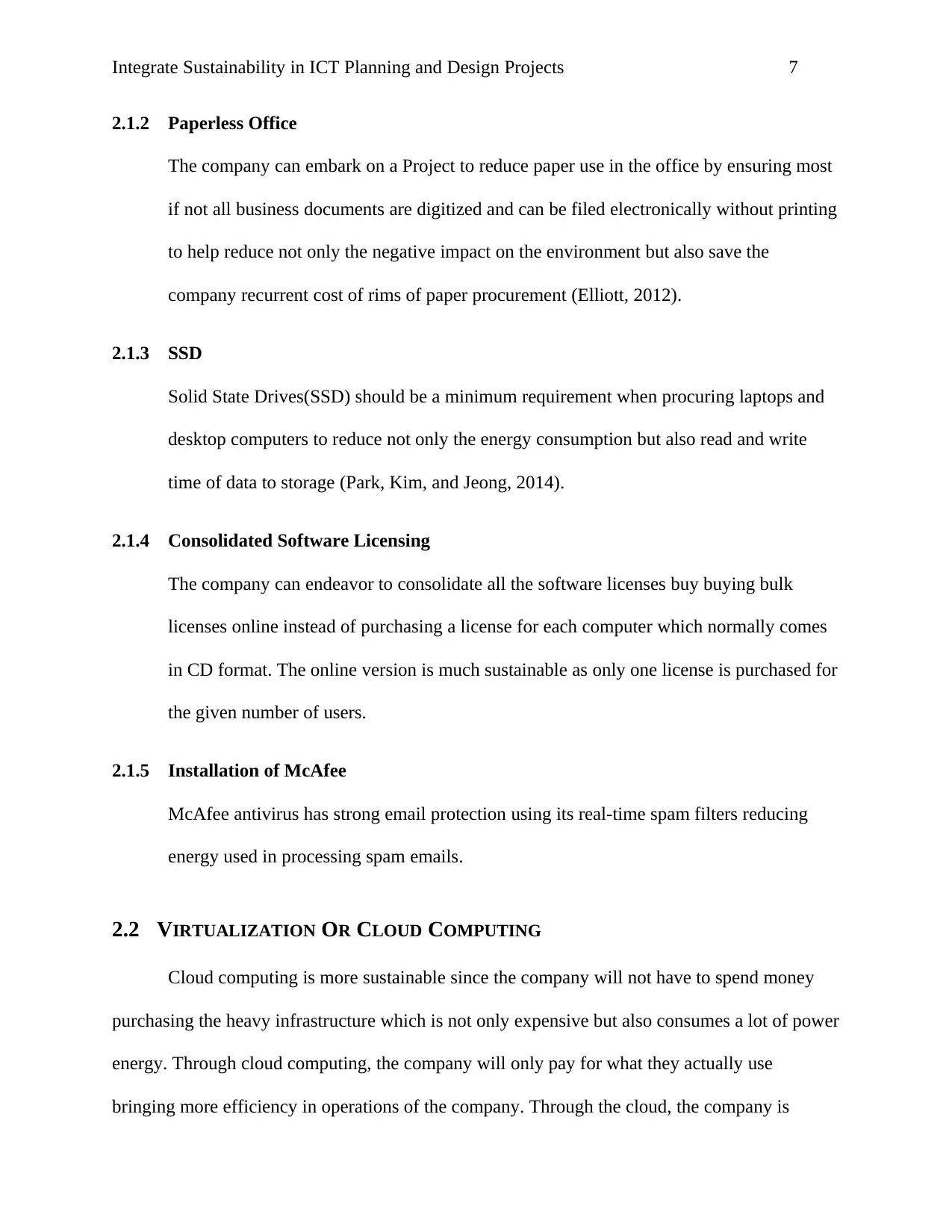
Integrate Sustainability in ICT Planning and Design Projects 7
2.1.2 Paperless Office
The company can embark on a Project to reduce paper use in the office by ensuring most
if not all business documents are digitized and can be filed electronically without printing
to help reduce not only the negative impact on the environment but also save the
company recurrent cost of rims of paper procurement (Elliott, 2012).
2.1.3 SSD
Solid State Drives(SSD) should be a minimum requirement when procuring laptops and
desktop computers to reduce not only the energy consumption but also read and write
time of data to storage (Park, Kim, and Jeong, 2014).
2.1.4 Consolidated Software Licensing
The company can endeavor to consolidate all the software licenses buy buying bulk
licenses online instead of purchasing a license for each computer which normally comes
in CD format. The online version is much sustainable as only one license is purchased for
the given number of users.
2.1.5 Installation of McAfee
McAfee antivirus has strong email protection using its real-time spam filters reducing
energy used in processing spam emails.
2.2 VIRTUALIZATION OR CLOUD COMPUTING
Cloud computing is more sustainable since the company will not have to spend money
purchasing the heavy infrastructure which is not only expensive but also consumes a lot of power
energy. Through cloud computing, the company will only pay for what they actually use
bringing more efficiency in operations of the company. Through the cloud, the company is
2.1.2 Paperless Office
The company can embark on a Project to reduce paper use in the office by ensuring most
if not all business documents are digitized and can be filed electronically without printing
to help reduce not only the negative impact on the environment but also save the
company recurrent cost of rims of paper procurement (Elliott, 2012).
2.1.3 SSD
Solid State Drives(SSD) should be a minimum requirement when procuring laptops and
desktop computers to reduce not only the energy consumption but also read and write
time of data to storage (Park, Kim, and Jeong, 2014).
2.1.4 Consolidated Software Licensing
The company can endeavor to consolidate all the software licenses buy buying bulk
licenses online instead of purchasing a license for each computer which normally comes
in CD format. The online version is much sustainable as only one license is purchased for
the given number of users.
2.1.5 Installation of McAfee
McAfee antivirus has strong email protection using its real-time spam filters reducing
energy used in processing spam emails.
2.2 VIRTUALIZATION OR CLOUD COMPUTING
Cloud computing is more sustainable since the company will not have to spend money
purchasing the heavy infrastructure which is not only expensive but also consumes a lot of power
energy. Through cloud computing, the company will only pay for what they actually use
bringing more efficiency in operations of the company. Through the cloud, the company is
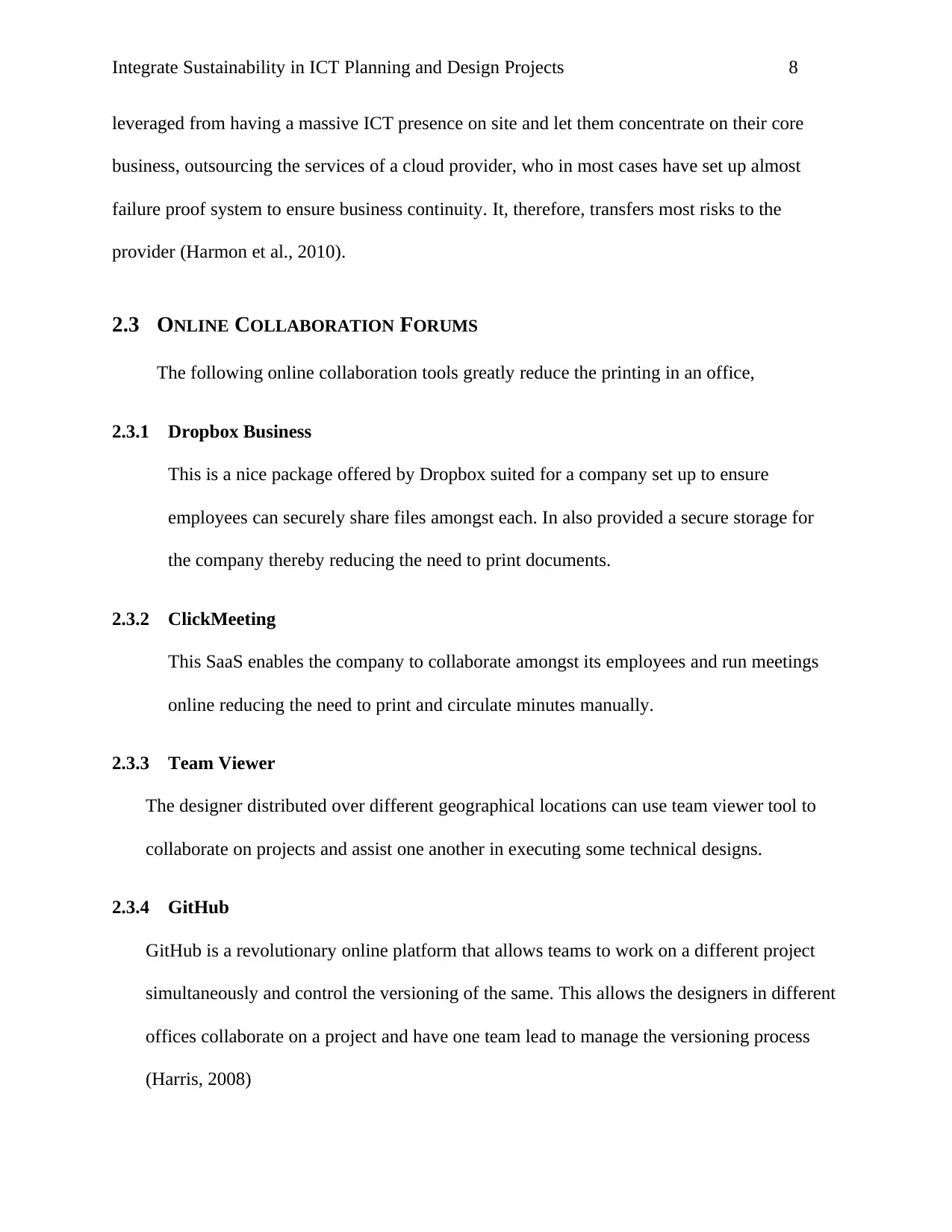
Integrate Sustainability in ICT Planning and Design Projects 8
leveraged from having a massive ICT presence on site and let them concentrate on their core
business, outsourcing the services of a cloud provider, who in most cases have set up almost
failure proof system to ensure business continuity. It, therefore, transfers most risks to the
provider (Harmon et al., 2010).
2.3 ONLINE COLLABORATION FORUMS
The following online collaboration tools greatly reduce the printing in an office,
2.3.1 Dropbox Business
This is a nice package offered by Dropbox suited for a company set up to ensure
employees can securely share files amongst each. In also provided a secure storage for
the company thereby reducing the need to print documents.
2.3.2 ClickMeeting
This SaaS enables the company to collaborate amongst its employees and run meetings
online reducing the need to print and circulate minutes manually.
2.3.3 Team Viewer
The designer distributed over different geographical locations can use team viewer tool to
collaborate on projects and assist one another in executing some technical designs.
2.3.4 GitHub
GitHub is a revolutionary online platform that allows teams to work on a different project
simultaneously and control the versioning of the same. This allows the designers in different
offices collaborate on a project and have one team lead to manage the versioning process
(Harris, 2008)
leveraged from having a massive ICT presence on site and let them concentrate on their core
business, outsourcing the services of a cloud provider, who in most cases have set up almost
failure proof system to ensure business continuity. It, therefore, transfers most risks to the
provider (Harmon et al., 2010).
2.3 ONLINE COLLABORATION FORUMS
The following online collaboration tools greatly reduce the printing in an office,
2.3.1 Dropbox Business
This is a nice package offered by Dropbox suited for a company set up to ensure
employees can securely share files amongst each. In also provided a secure storage for
the company thereby reducing the need to print documents.
2.3.2 ClickMeeting
This SaaS enables the company to collaborate amongst its employees and run meetings
online reducing the need to print and circulate minutes manually.
2.3.3 Team Viewer
The designer distributed over different geographical locations can use team viewer tool to
collaborate on projects and assist one another in executing some technical designs.
2.3.4 GitHub
GitHub is a revolutionary online platform that allows teams to work on a different project
simultaneously and control the versioning of the same. This allows the designers in different
offices collaborate on a project and have one team lead to manage the versioning process
(Harris, 2008)
⊘ This is a preview!⊘
Do you want full access?
Subscribe today to unlock all pages.

Trusted by 1+ million students worldwide
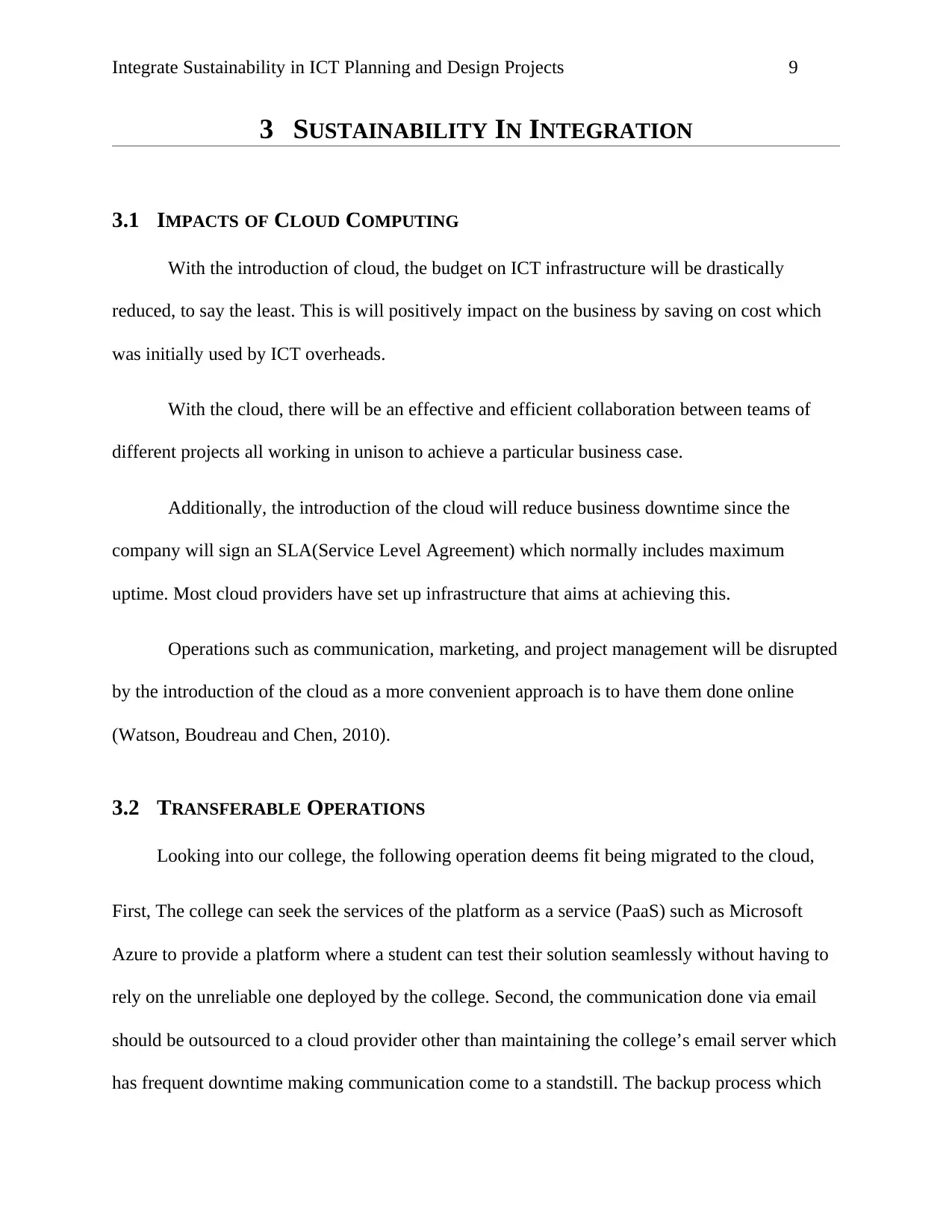
Integrate Sustainability in ICT Planning and Design Projects 9
3 SUSTAINABILITY IN INTEGRATION
3.1 IMPACTS OF CLOUD COMPUTING
With the introduction of cloud, the budget on ICT infrastructure will be drastically
reduced, to say the least. This is will positively impact on the business by saving on cost which
was initially used by ICT overheads.
With the cloud, there will be an effective and efficient collaboration between teams of
different projects all working in unison to achieve a particular business case.
Additionally, the introduction of the cloud will reduce business downtime since the
company will sign an SLA(Service Level Agreement) which normally includes maximum
uptime. Most cloud providers have set up infrastructure that aims at achieving this.
Operations such as communication, marketing, and project management will be disrupted
by the introduction of the cloud as a more convenient approach is to have them done online
(Watson, Boudreau and Chen, 2010).
3.2 TRANSFERABLE OPERATIONS
Looking into our college, the following operation deems fit being migrated to the cloud,
First, The college can seek the services of the platform as a service (PaaS) such as Microsoft
Azure to provide a platform where a student can test their solution seamlessly without having to
rely on the unreliable one deployed by the college. Second, the communication done via email
should be outsourced to a cloud provider other than maintaining the college’s email server which
has frequent downtime making communication come to a standstill. The backup process which
3 SUSTAINABILITY IN INTEGRATION
3.1 IMPACTS OF CLOUD COMPUTING
With the introduction of cloud, the budget on ICT infrastructure will be drastically
reduced, to say the least. This is will positively impact on the business by saving on cost which
was initially used by ICT overheads.
With the cloud, there will be an effective and efficient collaboration between teams of
different projects all working in unison to achieve a particular business case.
Additionally, the introduction of the cloud will reduce business downtime since the
company will sign an SLA(Service Level Agreement) which normally includes maximum
uptime. Most cloud providers have set up infrastructure that aims at achieving this.
Operations such as communication, marketing, and project management will be disrupted
by the introduction of the cloud as a more convenient approach is to have them done online
(Watson, Boudreau and Chen, 2010).
3.2 TRANSFERABLE OPERATIONS
Looking into our college, the following operation deems fit being migrated to the cloud,
First, The college can seek the services of the platform as a service (PaaS) such as Microsoft
Azure to provide a platform where a student can test their solution seamlessly without having to
rely on the unreliable one deployed by the college. Second, the communication done via email
should be outsourced to a cloud provider other than maintaining the college’s email server which
has frequent downtime making communication come to a standstill. The backup process which
Paraphrase This Document
Need a fresh take? Get an instant paraphrase of this document with our AI Paraphraser
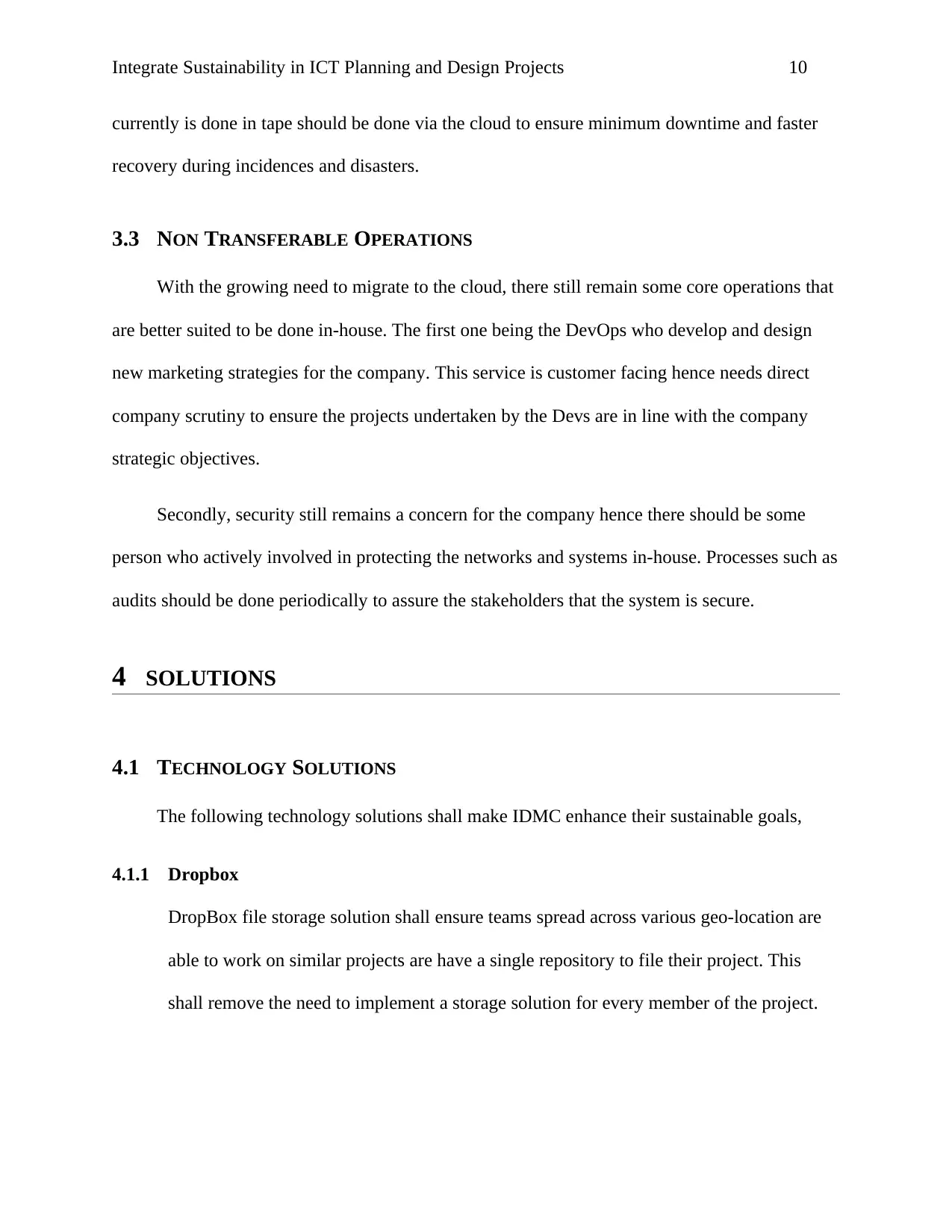
Integrate Sustainability in ICT Planning and Design Projects 10
currently is done in tape should be done via the cloud to ensure minimum downtime and faster
recovery during incidences and disasters.
3.3 NON TRANSFERABLE OPERATIONS
With the growing need to migrate to the cloud, there still remain some core operations that
are better suited to be done in-house. The first one being the DevOps who develop and design
new marketing strategies for the company. This service is customer facing hence needs direct
company scrutiny to ensure the projects undertaken by the Devs are in line with the company
strategic objectives.
Secondly, security still remains a concern for the company hence there should be some
person who actively involved in protecting the networks and systems in-house. Processes such as
audits should be done periodically to assure the stakeholders that the system is secure.
4 SOLUTIONS
4.1 TECHNOLOGY SOLUTIONS
The following technology solutions shall make IDMC enhance their sustainable goals,
4.1.1 Dropbox
DropBox file storage solution shall ensure teams spread across various geo-location are
able to work on similar projects are have a single repository to file their project. This
shall remove the need to implement a storage solution for every member of the project.
currently is done in tape should be done via the cloud to ensure minimum downtime and faster
recovery during incidences and disasters.
3.3 NON TRANSFERABLE OPERATIONS
With the growing need to migrate to the cloud, there still remain some core operations that
are better suited to be done in-house. The first one being the DevOps who develop and design
new marketing strategies for the company. This service is customer facing hence needs direct
company scrutiny to ensure the projects undertaken by the Devs are in line with the company
strategic objectives.
Secondly, security still remains a concern for the company hence there should be some
person who actively involved in protecting the networks and systems in-house. Processes such as
audits should be done periodically to assure the stakeholders that the system is secure.
4 SOLUTIONS
4.1 TECHNOLOGY SOLUTIONS
The following technology solutions shall make IDMC enhance their sustainable goals,
4.1.1 Dropbox
DropBox file storage solution shall ensure teams spread across various geo-location are
able to work on similar projects are have a single repository to file their project. This
shall remove the need to implement a storage solution for every member of the project.
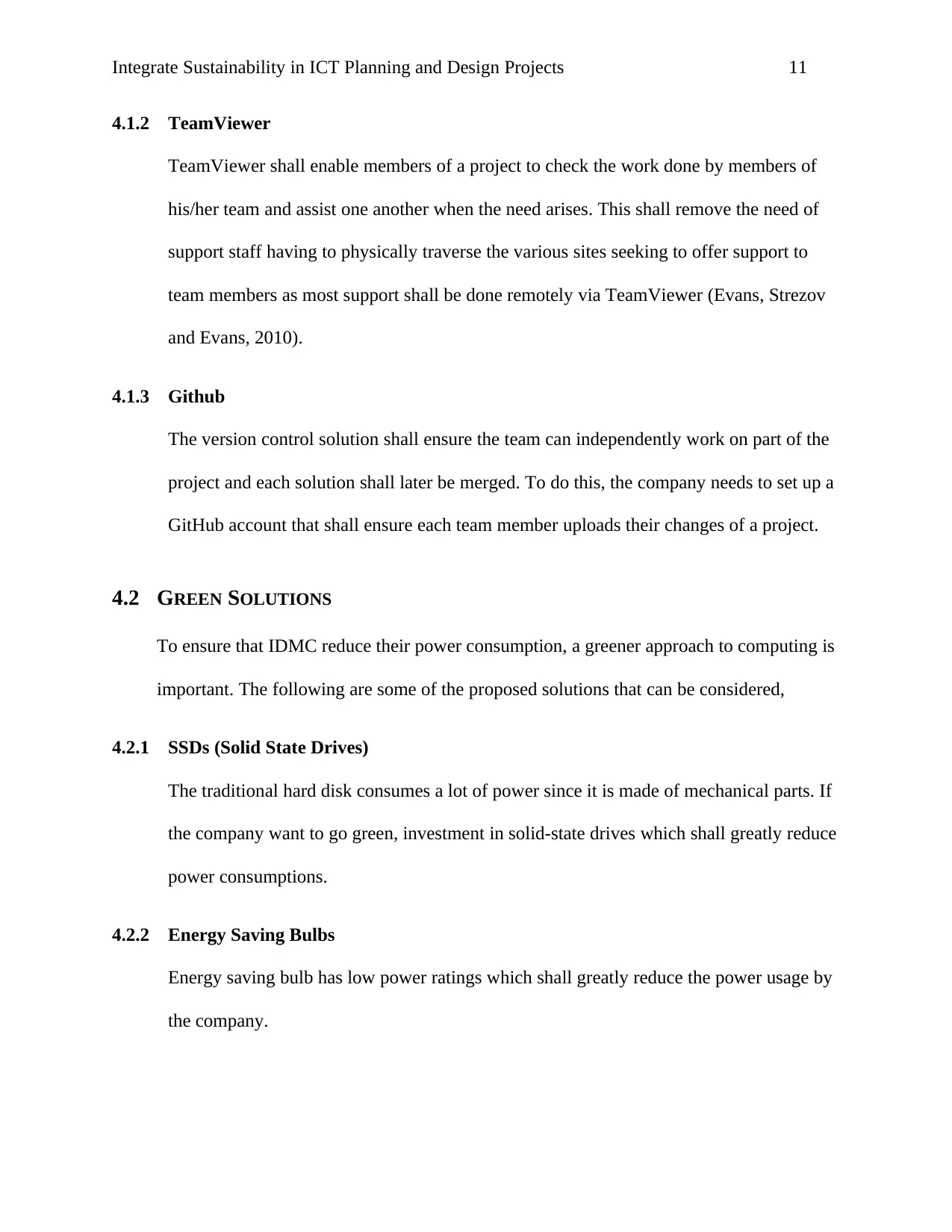
Integrate Sustainability in ICT Planning and Design Projects 11
4.1.2 TeamViewer
TeamViewer shall enable members of a project to check the work done by members of
his/her team and assist one another when the need arises. This shall remove the need of
support staff having to physically traverse the various sites seeking to offer support to
team members as most support shall be done remotely via TeamViewer (Evans, Strezov
and Evans, 2010).
4.1.3 Github
The version control solution shall ensure the team can independently work on part of the
project and each solution shall later be merged. To do this, the company needs to set up a
GitHub account that shall ensure each team member uploads their changes of a project.
4.2 GREEN SOLUTIONS
To ensure that IDMC reduce their power consumption, a greener approach to computing is
important. The following are some of the proposed solutions that can be considered,
4.2.1 SSDs (Solid State Drives)
The traditional hard disk consumes a lot of power since it is made of mechanical parts. If
the company want to go green, investment in solid-state drives which shall greatly reduce
power consumptions.
4.2.2 Energy Saving Bulbs
Energy saving bulb has low power ratings which shall greatly reduce the power usage by
the company.
4.1.2 TeamViewer
TeamViewer shall enable members of a project to check the work done by members of
his/her team and assist one another when the need arises. This shall remove the need of
support staff having to physically traverse the various sites seeking to offer support to
team members as most support shall be done remotely via TeamViewer (Evans, Strezov
and Evans, 2010).
4.1.3 Github
The version control solution shall ensure the team can independently work on part of the
project and each solution shall later be merged. To do this, the company needs to set up a
GitHub account that shall ensure each team member uploads their changes of a project.
4.2 GREEN SOLUTIONS
To ensure that IDMC reduce their power consumption, a greener approach to computing is
important. The following are some of the proposed solutions that can be considered,
4.2.1 SSDs (Solid State Drives)
The traditional hard disk consumes a lot of power since it is made of mechanical parts. If
the company want to go green, investment in solid-state drives which shall greatly reduce
power consumptions.
4.2.2 Energy Saving Bulbs
Energy saving bulb has low power ratings which shall greatly reduce the power usage by
the company.
⊘ This is a preview!⊘
Do you want full access?
Subscribe today to unlock all pages.

Trusted by 1+ million students worldwide
1 out of 40
Related Documents
Your All-in-One AI-Powered Toolkit for Academic Success.
+13062052269
info@desklib.com
Available 24*7 on WhatsApp / Email
![[object Object]](/_next/static/media/star-bottom.7253800d.svg)
Unlock your academic potential
Copyright © 2020–2025 A2Z Services. All Rights Reserved. Developed and managed by ZUCOL.





